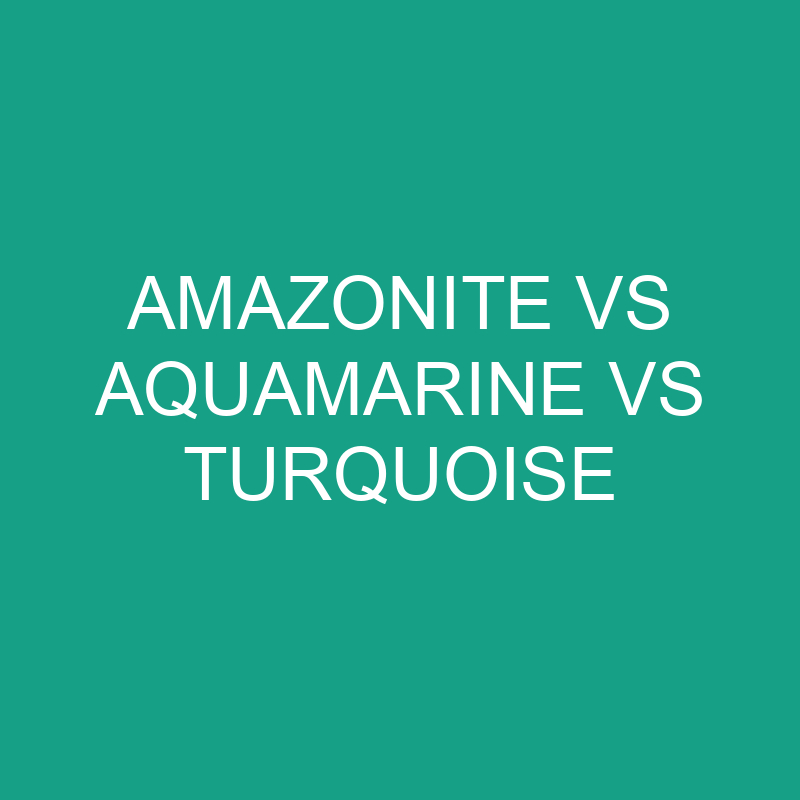Gemstones have captivated human beings for centuries, not just for their aesthetic appeal but also for the cultural, spiritual, and sometimes even healing properties attributed to them. Among the myriad of gemstones, Amazonite, Aquamarine, and Turquoise stand out for their distinctive beauty and unique characteristics. In this article, we will delve into the world of these captivating gemstones, exploring their origins, properties, uses, and the lore that surrounds them.
Post Contents
Amazonite: The Stone of Courage and Truth
Origins and Geology:
Amazonite, also known as the “Amazon Stone,” derives its name from the Amazon River, though it is not found in the Amazon rainforest. Instead, it is primarily mined in regions like Colorado, Brazil, India, and Madagascar. Composed of potassium feldspar, Amazonite often exhibits a captivating green to bluish-green hue, ranging from pale to vivid shades.
Physical and Metaphysical Properties:
- Color: Its distinctive green or blue-green color is caused by the presence of lead.
- Mohs Scale: Amazonite has a hardness ranging from 6 to 6.5 on the Mohs scale, making it moderately durable.
- Metaphysical Properties: Known as the “Stone of Courage” and the “Stone of Truth,” Amazonite is believed to empower its wearer to express thoughts and feelings with clarity. It is also thought to soothe emotional trauma and alleviate worry.
Uses:
- Jewelry: Amazonite is popularly used in jewelry, especially in the creation of necklaces, earrings, and bracelets.
- Decorative Items: Its vibrant colors make it a sought-after choice for carving into sculptures and decorative items.
Lore and Cultural Significance:
- Ancient Egypt: It is believed that Amazonite was used to create jewelry for the pharaohs of ancient Egypt.
- Greek Mythology: Some legends suggest that Amazonite was named after the mythical Amazon women warriors.
Aquamarine: The Gem of the Sea
Origins and Geology:
Aquamarine, with its enchanting blue hue reminiscent of the ocean, belongs to the beryl family. The name “Aquamarine” is derived from the Latin words “aqua” (water) and “marina” (of the sea). Brazil, Nigeria, and Madagascar are major sources of Aquamarine.
Physical and Metaphysical Properties:
- Color: Ranging from pale blue to deep blue-green, the color of Aquamarine is influenced by iron traces.
- Mohs Scale: With a hardness of 7.5 to 8 on the Mohs scale, Aquamarine is relatively durable.
- Metaphysical Properties: Aquamarine is associated with calmness, courage, and clear communication. It is believed to bring mental clarity and emotional balance.
Uses:
- Jewelry: Aquamarine is a popular choice for rings, earrings, and pendants, especially in engagement rings.
- Healing Practices: Some practitioners believe that Aquamarine has healing properties, promoting throat chakra balance and reducing stress.
Lore and Cultural Significance:
- Ancient Sailors: Sailors in ancient times believed that carrying Aquamarine would ensure a safe voyage and protect against sea monsters.
- Roman Beliefs: Romans associated Aquamarine with Neptune, the god of the sea.
Turquoise: The Stone of Protection
Origins and Geology:
Turquoise, prized for its vivid blue-green color, has been used in jewelry and ornamental items for thousands of years. Major deposits are found in countries like Iran, the United States (particularly in Arizona and New Mexico), China, and Mexico.
Physical and Metaphysical Properties:
- Color: The iconic blue color is caused by copper and iron elements.
- Mohs Scale: Turquoise has a hardness of 5 to 6, making it relatively soft compared to other gemstones.
- Metaphysical Properties: Regarded as a protective stone, Turquoise is associated with promoting spiritual attunement, enhancing communication, and providing solace for the spirit.
Uses:
- Jewelry: Turquoise is a staple in Native American jewelry and is often used in rings, bracelets, and earrings.
- Cultural and Spiritual Items: Many cultures use Turquoise in the creation of ceremonial objects and amulets for protection.
Lore and Cultural Significance:
- Native American Culture: Turquoise holds immense significance in Native American culture, symbolizing life, protection, and power.
- Persian Influence: In Persia, Turquoise has long been associated with good fortune and protection.
Comparative Analysis: Amazonite vs. Aquamarine vs. Turquoise
Color:
- Amazonite: Exhibits a range of green to blue-green shades.
- Aquamarine: Showcases a spectrum from pale blue to deep blue-green.
- Turquoise: Signature blue color with green undertones.
Hardness:
- Amazonite: 6 to 6.5 on the Mohs scale.
- Aquamarine: 7.5 to 8 on the Mohs scale.
- Turquoise: 5 to 6 on the Mohs scale.
Symbolism:
- Amazonite: Courage and truth.
- Aquamarine: Calmness, courage, and clear communication.
- Turquoise: Protection, spiritual attunement, and communication.
Cultural Significance:
- Amazonite: Linked to ancient Egypt and Greek mythology.
- Aquamarine: Associated with ancient sailors and Roman mythology.
- Turquoise: Integral to Native American culture and revered in Persian traditions.
Common Uses:
- Amazonite: Jewelry and decorative items.
- Aquamarine: Jewelry, especially engagement rings, and healing practices.
- Turquoise: Jewelry, cultural and spiritual items.
Conclusion: Choosing the Gemstone that Resonates with You
In the realm of gemstones, the choice between Amazonite, Aquamarine, and Turquoise ultimately comes down to personal preference. Each stone possesses its own unique charm, history, and purported metaphysical properties. Whether you are drawn to the courageous aura of Amazonite, the calming energy of Aquamarine, or the protective nature of Turquoise, these gemstones serve as not just adornments but as symbols of ancient wisdom and natural beauty. As you explore the vast world of gemstones, let your heart guide you to the one that resonates most with your spirit and style.

